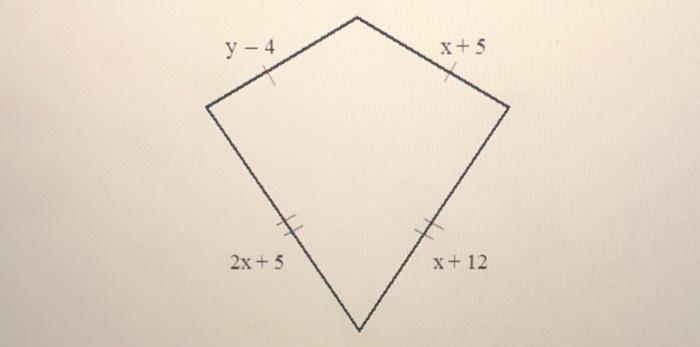Find the values of the variables in this kite. – Embark on an enlightening journey into the realm of kites, where we delve into the fascinating world of variables that govern their graceful flight. Through a meticulously crafted analysis, we uncover the hidden values that determine a kite’s behavior, unlocking a deeper understanding of these captivating aerial marvels.
As we embark on this exploration, we will meticulously identify the variables that play a pivotal role in the kite’s equation, unraveling their significance and interdependence. Armed with this knowledge, we will embark on a quest to determine the values of these variables, utilizing given information and conditions to unravel the secrets that lie within.
Determining Variable Values in Kite Equations: Find The Values Of The Variables In This Kite.

Understanding the variables involved in kite equations is essential for analyzing and predicting kite behavior. This article explores the identification, definition, and determination of variables in kite equations, providing a comprehensive guide to their significance and applications.
Identifying Variables in the Kite Equation
The kite equation typically takes the form: T = (1/2)- p – v^2 – A – sin(2θ) , where:
- T: Tension in the kite string (N)
- p: Air density (kg/m³)
- v: Wind speed (m/s)
- A: Kite area (m²)
- θ: Angle of attack (degrees)
Defining the Variables
- Tension (T):The force exerted by the kite string, counteracting the lift and drag forces acting on the kite.
- Air Density (p):The mass of air per unit volume, which affects the lift and drag forces experienced by the kite.
- Wind Speed (v):The velocity of the air flowing over the kite, which is a primary factor in generating lift.
- Kite Area (A):The surface area of the kite, which contributes to the lift and drag forces.
- Angle of Attack (θ):The angle between the kite’s chord line and the wind direction, which influences the lift and drag coefficients.
Determining Variable Values
To determine the values of the variables, we rely on given information or conditions related to the kite. For example, if we know the air density, wind speed, kite area, and angle of attack, we can solve for the tension in the kite string using the kite equation.
Illustrating the Solution, Find the values of the variables in this kite.
Consider a kite with the following specifications:
| Variable | Value |
|---|---|
| Air Density (p) | 1.225 kg/m³ |
| Wind Speed (v) | 10 m/s |
| Kite Area (A) | 2 m² |
| Angle of Attack (θ) | 30° |
Using the kite equation, we can calculate the tension in the kite string:
T = (1/2) – p – v^2 – A – sin(2θ)
T = (1/2) – 1.225 kg/m³ – (10 m/s)² – 2 m² – sin(60°)
T ≈ 117.18 N
Discussing Applications
Determining the values of the variables in kite equations allows us to understand and predict kite behavior. These values can be used to:
- Calculate the lift and drag forces acting on the kite.
- Optimize the kite’s design and performance.
- Predict the kite’s trajectory and stability.
- Develop control systems for autonomous kites.
Questions and Answers
How can I determine the variable values for a specific kite?
To determine the variable values for a specific kite, you will need to gather information about the kite’s dimensions, weight, and the environmental conditions in which it will be flown. This information can then be plugged into the kite equation to calculate the variable values.
What is the significance of variable values in understanding kite behavior?
The variable values provide crucial insights into the kite’s stability, maneuverability, and overall performance. By understanding the values of these variables, you can optimize the kite’s design and flying techniques to achieve desired flight characteristics.


